Oregon’s diverse environment is home to various creatures, including several species of roaches. In this blog, we’ll delve into the different types of cockroaches that residents might encounter in the Beaver State.
Identifying the Types of Roaches Found in Oregon
There are three main cockroach species that are prevalent in Oregon. These are the German cockroach, Oriental cockroach, and American cockroach. Let’s take a look at each one.
German Cockroaches

In Oregon, the German cockroach is the most prevalent species. German cockroaches reproduce rapidly and have the potential to infest a home entirely in a short period. It’s not only found statewide but also globally, posing potential health risks, especially to children.
Distinct Characteristics
To recognize a German cockroach, note that adults are smaller than many other roaches, measuring about a half inch in length. Their light caramel-brown bodies are elongated, but the most distinguishing feature is the two dark stripes located just behind their head.
It’s essential to differentiate between young German cockroaches and their mature counterparts. The younger stages are dark and small, lacking the distinctive stripes behind the head. Surprisingly, they closely resemble the young stages of American roaches.
Life Cycle and Reproduction
German cockroach populations undergo a life cycle known as incomplete metamorphosis. It starts from an egg, then the nymph stages, and finally the adult stage. A single female German cockroach can produce several egg capsules in her lifetime, with each capsule containing 30-40 eggs. This rapid reproduction is why infestations can quickly spiral out of control.
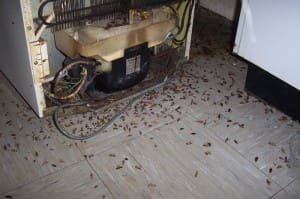
Habitats and Hiding Spots
Primarily, German roaches are found inside buildings, but in warmer months and when their numbers swell, they can be spotted outside, especially near trash dump sites and dirty areas. Their preferred habitats are within electronic devices and electrical outlets.
Initially, they tend to populate kitchens, hiding in electrical outlets, refrigerator compressors, toasters, microwaves, coffee makers, and kitchen cabinets.
As their numbers grow, German roaches expand their territory, moving to bathrooms and eventually bedrooms. Typically, they’re nocturnal creatures, becoming more active at night, especially when their numbers are few. Daytime sightings often indicate a significant infestation.

Prevention
Understanding their behavior and preferences is key to preventing an infestation. Here are some preventative steps:
- Maintain cleanliness to deter these pests.
- Vacuum regularly to remove food particles and potential egg casings.
- Store food in sealed containers.
- Promptly repair any leaks to deprive them of moisture.
Remember, German cockroaches are vectors for diseases such as E. coli and salmonella. They can also trigger allergies and asthma, particularly in children.
If you suspect a German roach infestation, it’s crucial to seek professional intervention. These pests are resilient, necessitating specialized treatments. Thankfully, our trained professionals are well-equipped to handle them, understanding their habitats, entry points, and behaviors.
Oriental Cockroaches
The Oriental cockroach is a common pest that can be easily identified by its distinctive appearance and habits. Almost black in color with a penchant for damp environments, these roaches pose potential health risks if they invade living spaces. Here’s what you need to know about identifying this particular pest.

Distinct Characteristics
How can one recognize Oriental cockroaches? For identification, focus on their size and color. Oriental roaches are almost black, exhibiting reddish undertones, and measure between 1 to 1.25 inches in length.
They bear a resemblance to beetles, equipped with wings but lacking the ability to fly. Their bodies are distinctly flat with a glossy exterior. A notable trait is their affinity for moisture, which leads them to frequent areas close to toilets, sinks, and exposed plumbing indoors.
Life Cycle and Reproduction
The life cycle of an Oriental cockroach spans about a year, depending on the environment. The female produces around eight egg capsules in her lifetime, with each containing about 16 eggs. Once hatched, nymphs undergo seven to ten moltings before reaching adulthood.
Habitats and Hiding Spots
Like most cockroach species, Oriental cockroaches thrive on decomposing organic matter, showing a preference for dim, moist environments. While they are predominantly outdoor pests, they commonly inhabit areas like water meter boxes, underneath leaf piles, and in the vicinity of trash containers.
When found indoors, it’s usually in spaces below the ground, such as basements or crawl areas. Their inability to navigate smooth surfaces can sometimes trap them in bathtubs. A significant concern with Oriental roaches is their penchant for water and sewage, making them potential carriers of harmful bacteria.
If they invade kitchen areas, there’s a risk of transmitting these bacteria, which can lead to various health issues like food poisoning and gastrointestinal troubles.
Prevention
Often mistaken for palmetto bugs, the Oriental cockroach is a moisture-loving pest that can pose significant health risks if not managed properly. Below are some prevention tips to keep infestations at bay:
- Manage moisture; use dehumidifiers in damp areas.
- Fix leaky pipes to minimize water sources.
- Ensure good ventilation, especially in basements or crawl spaces.
Oriental roaches traverse through sewers and decaying matter, making them potential carriers of germs and pathogens. A clean home is less attractive to these pests and can mitigate health risks.
Should you encounter Oriental roaches in your living space, know that solutions are available. Our technicians utilize professional-grade products to effectively and swiftly eradicate these pests.
American Cockroaches
The American cockroach, often mistaken for a palmetto bug, is a sizable pest distinct in its appearance and behavior. As we delve deeper, we’ll explore their habits and common hiding spots within homes.
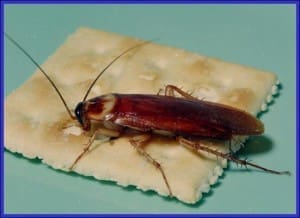
Distinct Characteristics
Known for its size, often measuring between 1.5 to 2 inches or even larger, this reddish-brown pest boasts an oval shape and wings that allow it to fly short distances. Although known to dart quickly when exposed to light, it’s not just their speed that’s noteworthy; their feeding habits and preferred hiding spots make them a unique challenge in pest control.
Life Cycle and Reproduction
American cockroach nymphs undergo several molting phases, taking around 600 days to mature into adults. A female can produce up to 90 egg capsules in her life, each containing about 15 eggs. This species has a longer life cycle compared to the German and Oriental cockroaches.
Habitats and Hiding Spots
American roaches have a diverse palate. While they favor decaying organic matter, they aren’t picky eaters. From book bindings and paper to cloth, syrups, and sweets, they can consume a wide variety of materials.
So where might one encounter these roaches indoors? Typically, they seek out dark, secluded areas. Basements, crawl spaces, and even sprinkler irrigation boxes are among their favored spots. Additionally, they can be found lurking around tubs, inside clothes hampers, drainage pipes, or outdoors under broken concrete.
Prevention
One of the more recognizable types of cockroaches, the American cockroach, is known for its size and speed. While not as rapidly reproducing as the German cockroach, its resilience makes prevention paramount. Below are tips to prevent an infestation:
- Ensure proper home insulation to deter these warmth-seeking pests.
- Seal cracks and gaps around the home.
- Store food properly, using airtight containers.
Like other roaches, American cockroaches can carry pathogens due to their scavenging habits. Regular home inspections and professional treatments can reduce the risk they pose.
Managing American cockroaches requires a strategic approach. Given their adaptability and diverse hiding spots, tailored solutions are essential to tackle their presence effectively if a cockroach infestation has already taken hold. Enlisting professional help can ensure a thorough assessment and application of the most effective treatment to keep these pests at bay.
Are Cockroaches Found throughout Oregon?
Absolutely. Roaches have been found in various cities across the state. The influx of people moving to the Northwest from warmer climates, where cockroaches are more common, has significantly contributed to the rise in cockroach populations.
Both urban areas, including prominent regions like Portland, and rural settings are not immune to these pests. Their prevalence is often linked to areas with suboptimal sanitation, providing them ample opportunities to feed and reproduce. Unfortunately, the inadequate sanitation practices observed in some cities can inadvertently encourage their growth.
However, it’s not just large cities that face this issue. Smaller towns are equally vulnerable. Cockroaches have a knack for infiltrating spaces in numerous ways. They can hitch a ride inside cardboard boxes, groceries, appliances, and other household items.
Due to their small size, they can easily conceal themselves in minuscule cracks and gaps, finding entry points into homes. Once inside, their stealthy nature allows them to remain hidden, often going unnoticed as they prefer dark, secluded spots.
Stop a Roach Infestation in Its Tracks Today
To address this pervasive issue, Bug Zapper offers integrated pest management and cockroach control solutions that are both swift and highly effective. Leveraging our deep knowledge of common cockroach behaviors, we tailor our approach to suit the unique challenges each roach species presents, ensuring complete cockroach elimination from all corners of your home, office, or living space.
Don’t take chances with your health. All roaches spread disease and are nasty. Call us at 541-672-6339 or contact us here to schedule a 100% guaranteed roach cleanout and prevention treatment today.
Locally owned for fast, exceptional service.

Call or Text 541-636-0146 or contact us here to schedule today.
We treat cockroaches throughout Oregon, including Albany, Ashland, Corvallis, Eugene, Grants Pass, McMinnville, Medford, Newberg, Roseburg, Salem, Sherwood, Wilsonville, Woodburn, Tigard, Tualatin and surrounding areas.

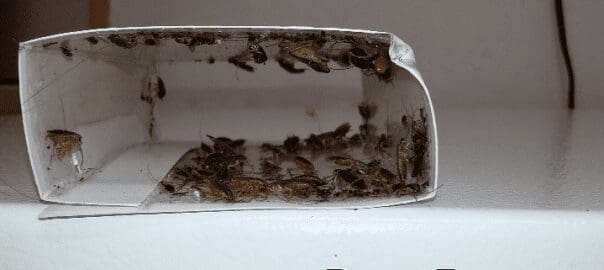
 Termites in Oregon: Are Termites a Problem in Oregon?
Termites in Oregon: Are Termites a Problem in Oregon? Boxelder Bug Oregon: Understanding Stink Bugs and Box Elder Beetles
Boxelder Bug Oregon: Understanding Stink Bugs and Box Elder Beetles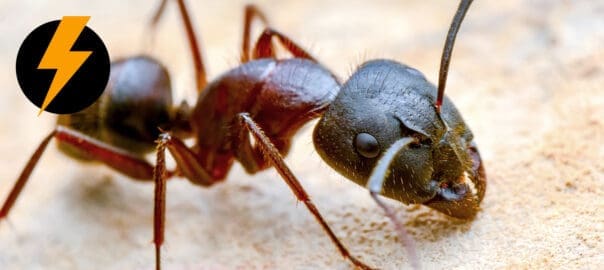 Kinds of Ants: Identifying Common Ants in Oregon
Kinds of Ants: Identifying Common Ants in Oregon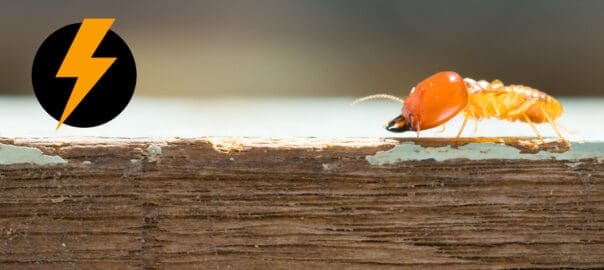 Termites in Oregon: Are Termites a Problem in Oregon?
Termites in Oregon: Are Termites a Problem in Oregon? How To Choose A Pest Control Service
How To Choose A Pest Control Service